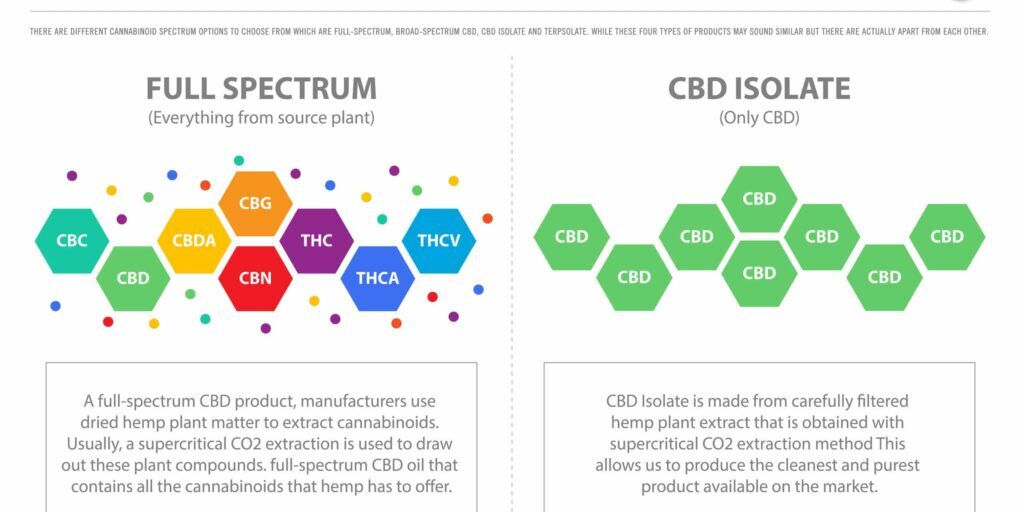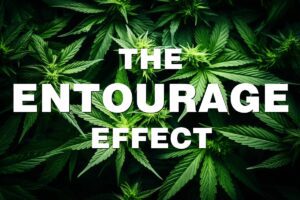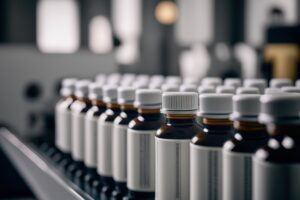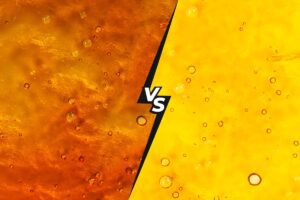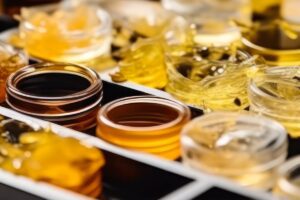Overview Of Hemp Compounds
Naturally occurring chemical compounds in hemp exert healthful pharmacological effects. For example, myrcene alone performs biological activities that include antibacterial, analgesic, anticancer, antidiabetic, antioxidant, sedative, anti-inflammatory and antibacterial effects. Many more compounds contribute unique benefits as well. The hemp plant from which CBD is extracted contains different beneficial compounds and phytochemicals.
Cannabinoids
A class of compounds that includes many chemicals, cannabinoids exist in abundance in the cannabis plant. They can produce effects on appetite, memory, mood, sleep and pain, among other beneficial functions.
- CBD
Cannabidiol, a non-psychoactive chemical compound in the flower of the cannabis plant - CBN
Cannabinol, a mild psychotropic compound in mature hemp plants - CBG
Cannabigerol, one of the rarer cannabinoid concentrations in hemp and the Rolls Royce of cannabinoids - CBGA
- Cannabigerolic Acid, a foundational compound for other cannabinoids
- CBC
Cannabichromene, one of the most prominent compounds in cannabis plants - CBDV
Cannabidivarin, a non-intoxicating compound structure similar to CBD - THC (Delta 9)
Tetrahydrocannabinol, a psychoactive compound in cannabis
Terpenes
Aromatic compounds in plants produce the aroma of pine, lavender, citrus, rosemary and other scents. Terpenes are among the most plentiful compounds in nature, and Cannabis plants contain high concentrations of them. Cannabiva Full and Broad Spectrum CBD blends contain 25 terpenes at active concentration levels. Some that you will find include Myrcene, Limonene, Caryophyllene, Linalool, Terpineol, Humulene, Eucalyptol and Camphene.
Limonene produces the refreshing smell of citrus as you may imagine, but terpineol has a woody-lime profile as well. Humulene imparts a flavor reminiscent of hops in beer. Linalool offers a sweet and floral scent. The unique benefits that each possesses can contribute to the entourage effect. Some companies add non-cannabis plant-based terpenes, including some that add the perception of different flavors. However, we reject that practice.
A true full spectrum CBD oil and broad spectrum CBD oil like the blends manufactured by Cannabiva are infused with pure Cannabis terpenes ONLY… no imitations.
Flavonoids
Scientific studies show actions that flavonoids exert against health disorders, some of which have dire medical impacts such as cancer and chronic inflammation. Capable of providing antioxidant properties, flavonoids promote overall health and potentially lower the risk of disease. Fortunately, they exist in abundance in nature and in the cannabis plant especially.
Chlorophyll
Cannabis produces chlorophyll throughout its life cycle to produce a crucial component of the plant’s nutrition.
Triterpenoids
While the root of the cannabis plant has no significant amount of cannabinoids, it provides a rich storehouse of triterpenes and phytosterols.
Lipids
While not conclusive, research seems to indicate that cannabis may affect the lipid profile and make it slightly more favorable.
How CBD And Hemp Extracts Work In The Body’s Endocannabinoid System
The endocannabinoid system (ECS) may have more signaling capacity than was previously known. Science has found that modulating factors include sleep and exercise, stress and phytocannabinoids like Cannabidiol (CBD). ECS exists in your body whether you use cannabis or not. The system regulates your rest, interest in food, what you remember, your mood and even reproduction. It manages pain and inflammation, your cardiovascular system, motor control and more.
Three components of the ECS include endocannabinoids that assist the smooth operation of your internal functions. Receptors attract endocannabinoids to bind to them and alert the ECS to take action. For example, they might attach to a receptor that reports pain or inflammation. Enzymes break down endocannabinoids so that they can perform an intended function. THC binds with the receptors just as endocannabinoids do. CBD seems not to bind with them, unlike THC.
CBD Entourage Effect
Unique properties may occur from the combination of various compounds in cannabis. Studies of the entourage effect show that the compounds work in unison to influence anxiety, insomnia, pain and inflammation, impulse control and other conditions. Synergistic interaction between compounds expands possibilities for the benefits of cannabis.
When cannabinoids and terpenes combine with other phytochemicals in cannabis, the entourage effect harnesses the power of the whole plant. Full spectrum and broad spectrum oils contain whole-plant extracts, making them use the entourage effect in presenting the beneficial compounds in hemp.
The Three Types Of CDB Blends (Differences And Similarities)
Unique formulations for the three types of blends exist in the careful preparation of CDB products. Differences start with extraction and continue through post-extraction processing and filtering. In addition, they exist in the consistency and viscosity of the raw distillate or isolate extract. Thus, differences affect the color, aroma, taste and cannabinoid/terpene lab profile.
Full Spectrum CBD
Cannabiva Full Spectrum CBD Oil gives you the strongest cannabinoid profile that is loaded with terpenes and flavonoids. In addition to Cannabidiol (CBD), the active ingredient, it contains Cannabinol (CBN), Cannabigerol (CBG) and Cannabichromene (CBC). While it includes detectable levels of THC, a psychoactive cannabinoid, the amounts remain within the legal limit.
As our most popular blend type, it uses a legal cannabis strain that the U.S. Department of Agriculture approves for hemp-derived products. We extract our Full Spectrum CBD products from hemp using either CO2, sugar cane ethanol or lipid extraction. The extraction process creates a gold or amber-colored distillate that resembles honey or molasses in consistency. At room temperature, the high concentration of cannabidiol may allow it to crystallize or harden.
Our formulation produces a rich concentration of cannabis terpenes and delivers an aroma that smells like weed. Our extracts have a natural hemp flavor, with the higher quality blends providing a stronger taste. Most clinical studies use Full Spectrum CBD blends to perform research. Clients who need to take regular drug tests for employment may prefer a different blend that contains no THC.
Broad Spectrum CBD
Our Broad Spectrum CBD products contains no detectable levels of THC, the only difference that distinguishes it from full spectrum. Tested at 0.0% THC, it gives you the same rich experience with essential cannabinoids containing Cannabinol (CBN), Cannabigerol (CBG), and Cannabichromene (CBC) throughout every dosage. In addition, it contains as much terpene and flavonoid as full spectrum. You may not even notice the difference as it lets you avoid THC altogether.
Cannabiva Broad Spectrum CBD has a milder natural hemp aroma than Full Spectrum CBD Oil, and the taste is lighter as well. The gold or amber shades may be lighter than Full Spec as we provide additional processing to remove THC after extraction. Lab tests cannot detect the low levels of THC, and most drug tests will not detect them either. However, the best way to avoid a positive result is to take Pure Isolate CBD oil instead to be sure.
Pure Isolate CBD
Zero High CBD Isolate Oil contains only CBD oil and no cannabinoids, terpenes or flavonoids, it gives you the CBD concentration of full spectrum and broad spectrum with no chance of experiencing any THC.
Requiring more processing after extraction than full spectrum or broad spectrum blends, the isolating process separates the cannabidiol from cannabinoids, terpenes or other compounds. In addition, we use winterization to cool the extract to subzero temperatures. Then we heat it back up to isolate specific compounds. The process produces a fine white powder that contains 99% pure Cannabidiol. You can find recommendations for how much to take on our CBD Dosage Chart.
It has no aroma. Pure isolate CBD oil is clear, but it may assume the flavor of its base such as hemp seed oil, jojoba oil, tea or even foods. A color change may occur with exposure to light and temperature, but it does not change anything else. Refrigeration may help it retain its original color.
Comparison Chart of CDB Blends
Use the following chart to compare the similarities and differences between Full Spectrum CBD, Broad Spectrum CBD and Pure CBD Isolate Oil.
CBD Comparison Chart: Full Spectrum / Broad Spectrum / Pure CBD Isolate |
|||
|---|---|---|---|
| Full Spectrum CBD | Broad Spectrum CBD | Pure CBD Isolate | |
| Contains CBD | Yes | Yes | Yes |
| Minor Cannabinoids (CBN, CBG, CBC) |
Yes | Yes | No |
| Terpenes | Yes | Yes | No |
| Flavonoids | Yes | Yes | No |
| THC | Yes (less than 0.3%) |
THC-Free (0.0%) |
THC-Free (0.00%) |
| Aroma | Natural Hemp | Natural Hemp | Odorless |
| Taste | Natural Hemp | Natural Hemp | Flavorless |
| Color | Gold / Amber | Gold / Amber | Clear |
| Base Extract | Full Spectrum Distillate | Broad Spectrum Distillate | Pure Isolate Powder |
| CBD Oil Tincture | Full Spectrum CBD Oil | Broad Spectrum CBD Oil | CBD Isolate Oil |
| CBD Softgels | Full Spectrum CBD Softgels | Broad Spectrum CBD Softgels | - |
| CBD Gummies | Full Spectrum CBD Gummies | Broad Spectrum CBD Gummies | - |
CBD Blends: Pros and Cons
Our three artisanal blends have differences that distinguish them but do not make one superior to another. Your choice of full spectrum, broad spectrum or pure isolate CBD depends on your specific needs. Each type provides unique benefits that may meet your requirements or not. However, your understanding of the differences, now that you know them, may encourage you to use the pros and cons guide to determine which CBD blends work the best for you.
Full Spectrum CBD Pros and Cons
Full Spectrum CBD Pros
-
The least processed form of CBD extract
-
Maintains necessary hemp compounds for optimal entourage benefits including CBD, CBN, CBC, and terpenes
-
For users with complex wellness needs
Full Spectrum CBD Cons
-
May yield positive drug test results in users taking high doses of full spectrum CBD products
-
Natural hemp aroma and flavor may be strong for some users
Who should use full spectrum CBD?
-
Users with complex CBD wellness needs
-
People wanting to maximize the entourage effects of CBD oils
-
Those who are OK with low, non-psychoactive levels of THC in their blends
Broad Spectrum CBD Pros and Cons
Broad Spectrum CBD Pros
-
Elicits the entourage effect
-
No detectable levels of THC
-
Milder hemp flavor and aroma than full spectrum
Broad Spectrum CBD Cons
-
Entourage Effect may be lessened due to additional extraction processes involved
-
Not as extensively studied as Full Spectrum CBD
Who should use broad spectrum CBD?
-
Users who are sensitive to THC
-
Those who still want to experience the benefits of the entourage effect
Pure Isolate CBD Pros and Cons
Pure Isolate CBD Pros
-
Contains no THC
-
Contains only Cannabidiol and no additional hemp extract compounds
-
Has no aroma or taste
Pure Isolate CBD Cons
-
No entourage effects with the absence of terpenes and all cannabinoids except Cannabidiol (CBD)
-
Not as extensively studies as full spectrum CBD and broad spectrum CBD
Who should use pure isolate CBD?
-
Individuals who are sensitive or allergic to other hemp compounds
-
Those who are concerned about a positive THC drug test result
-
Users who prefer blends that have no strong aroma or taste
Summarizing the Differences Between the Types of CBD Oil
Now that you have read the details about differences in blends, here is what they mean in a nutshell.
Full Spectrum CBD Oil offers a robust cannabinoid profile replete with terpenes and flavonoids, Cannabinol (CBN), Cannabigerol (CBG), Cannabichromene (CBC) and the active ingredient Cannabidiol (CBD). It contains a legal level of THC and is our most popular blend.
Broad Spectrum CBD Oil is identical in every way to full spectrum except it has no detectable level of THC. A favorite choice of users who want to avoid THC entirely, it has no distinguishable difference from full spectrum.
CBD Isolate Oil contains no other cannabinoids, terpenes, flavonoids or THC whatsoever and is preferred by users who do not want the taste or aroma of full spectrum and broad spectrum extracts.




